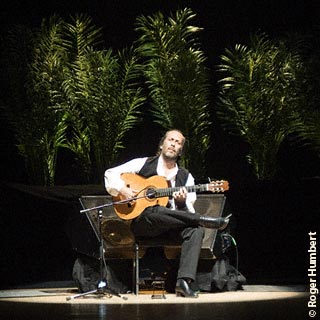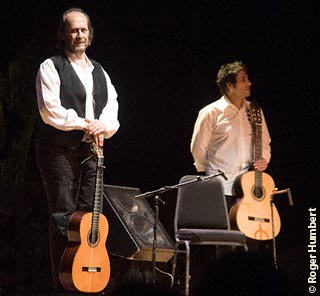
|
| Paco de Lucia |
| January 29, 2007 • Massey Hall • Toronto |
|
|
Flamenco – Past, Present and Future
by Joyce Corbett with photos by Roger Humbert |
| The stage is set for seven musicians, but for the first piece, Paco de Lucia walks out alone, guitar in hand, accompanied by applause, whistles, and shouts. He takes his seat in the spotlight against a backdrop of palm fronds, and as he starts to play, the audience falls into silent wonder. Long-vibrating notes are allowed to linger and dissipate, high lightning runs are underscored by deeply ominous chords, the duende, sometimes defined as the dark, creative force. Other notes’ lives are cut short, sometimes violently. Sudden, brief silences create suspense. This is dramatic music, harsh and delicate, full of contrasts. The build is slow and organic. The slight vital figure of the virtuoso on the chair is playing but the extraordinary music seems to be emerging from another world. There are sumptuous, thick harmonies, melodies and countermelodies, and a sudden snap. Annoyed and frustrated, Paco de Lucia’s eyes scan and scour stage left and right for help. Abandoning the silent search, he says “Very sorry, I am going to look for another chair, this is too low, I can’t play like this”. It was a rude awakening, but a moment that I likely would have forgotten, if not for my notes. After a suitable chair was found, the dream-trance, in flamenco terms, also the duende continued. |
| The program listed not song titles, but nine different flamenco forms or styles, out of the many that exist, leaving lots of room for the expression and manifestation of the soul (duende once again). The cajon and djembe set the second piece in motion, two singers entered, clapping, Paco played and the women’s voices, their cries of exorcism wrenched our souls. The third piece was a Buleria, a high-spirited piece prompting lots of improvisation, lots of communication between the two percussionists and Paco de Lucia, and culminating in laughter and the patting of backs. Alone once more on stage, Paco de Lucia played a beautiful Minera. In the first half of the show, the full sextet was on stage only for the final piece, an Alegria with 12/8 rhythm and complex palmas or hand-clapping precisely performed by keyboard player, Antonio Serrano, bass player, Alain Perez, second guitarist, Nino Josele and the two vocalists, Chonchi Heredia and Montserrat Cortes while Israel Suarez Pirana played cajon and Paco de Lucia played guitar. Towards the end of the piece, Serrano took up his electric bass and Perez his guitar, giving us a taste of things to come in the second half of the show.
Aside from his phenomenal ability as a guitarist, Paco de Lucia is known for the innovations he has brought to flamenco. On a trip to Peru he discovered the sound of the cajon and liked it so much he brought one home with him. Now, it is an integral part of flamenco and there are cajones especially made for flamenco, usually with an internal snare. Traditional flamenco already used percussion with the stamping of feet, the clapping of hands and the occasional slap on the guitar body so the slapping of a wooden box merges smoothly while adding something new. Under the influence of fusion jazz, Paco de Lucia also brought the electric bass to flamenco, (a more foreign addition, though still in the guitar family), and the electric keyboard.
|
|

Paco de Lucia |
|

Paco de Lucia & Nino Josele |
|
|
| The second half of the show, for the most part, used the entire sextet, sometimes developing great percussive grooves, once with the keyboard player switching to guitar. What was new to me was the harmonica. When it was played as another colour in the mix of timbres I liked it, but, when the harmonica came in after the visceral vocals, it seemed too clean and thin. A more bluesy harmonica sound, less pure, may have fit in better. However, the phrasing and the rhythm were perfect, wholly flamenco, a whole new style of harmonica.
In the last piece of the evening, the “Zyryab” I enjoyed the brightness of the harmonica solo played against a dark, brooding and intense musical foundation. This was very much a jazz-style piece with solos moving through the circle from one musician or singer to the next and each one mesmerizing. The only thing missing was a dancer. I would have liked to witness the duende rising through the feet of the dancer and taking possession.
Of course, an encore was demanded and generously given by Paco de Lucia and the sextet. I had never before experienced the Moorish influence of the arches of Massey Hall. What a perfect setting for flamenco.
|
|
|
|
|
|
|



